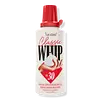What's inside
What's inside
 Key Ingredients
Key Ingredients

 Benefits
Benefits

 Concerns
Concerns

 Ingredients Side-by-side
Ingredients Side-by-side

Zinc Oxide 9.4%
Cosmetic ColorantWater
Skin ConditioningDimethicone
EmollientPropylene Glycol
HumectantC12-15 Alkyl Benzoate
AntimicrobialSorbitan Oleate Decylglucoside Crosspolymer
CleansingCetearyl Alcohol
EmollientArgania Spinosa Kernel Oil
EmollientAmmonium Acryloyldimethyltaurate/Vp Copolymer
Tocopheryl Acetate
AntioxidantGlycerin
HumectantSqualane
EmollientButyrospermum Parkii Butter Extract
Skin ConditioningPolyester-5
Caprylyl/Capryl Glucoside
CleansingCoco-Glucoside
CleansingC14-22 Alcohols
Emulsion StabilisingHydroxyethyl Acrylate/Sodium Acryloyldimethyl Taurate Copolymer
Emulsion StabilisingTriethoxycaprylylsilane
Ethyl Ferulate
AntioxidantC12-20 Alkyl Glucoside
EmulsifyingBisabolol
MaskingSodium Chloride
MaskingPhospholipids
Skin ConditioningGluconolactone
Skin ConditioningBenzyl Alcohol
PerfumingSodium Benzoate
MaskingChlorphenesin
AntimicrobialSorbic Acid
PreservativeUrea
BufferingPhenoxyethanol
PreservativeEthylhexylglycerin
Skin ConditioningZinc Oxide 9.4%, Water, Dimethicone, Propylene Glycol, C12-15 Alkyl Benzoate, Sorbitan Oleate Decylglucoside Crosspolymer, Cetearyl Alcohol, Argania Spinosa Kernel Oil, Ammonium Acryloyldimethyltaurate/Vp Copolymer, Tocopheryl Acetate, Glycerin, Squalane, Butyrospermum Parkii Butter Extract, Polyester-5, Caprylyl/Capryl Glucoside, Coco-Glucoside, C14-22 Alcohols, Hydroxyethyl Acrylate/Sodium Acryloyldimethyl Taurate Copolymer, Triethoxycaprylylsilane, Ethyl Ferulate, C12-20 Alkyl Glucoside, Bisabolol, Sodium Chloride, Phospholipids, Gluconolactone, Benzyl Alcohol, Sodium Benzoate, Chlorphenesin, Sorbic Acid, Urea, Phenoxyethanol, Ethylhexylglycerin
Homosalate 7.5%
Skin ConditioningOctocrylene 5%
UV AbsorberEthylhexyl Salicylate 5%
UV AbsorberButyl Methoxydibenzoylmethane 3%
UV AbsorberAloe Barbadensis Leaf Juice
Skin ConditioningAminomethyl Propanol
BufferingButyloctyl Salicylate
Skin ConditioningCocos Nucifera Oil
MaskingDimethicone
EmollientEthylhexylglycerin
Skin ConditioningParfum
MaskingGlycerin
HumectantMicrocrystalline Cellulose
AbsorbentMusa Sapientum Fruit Extract
Skin ConditioningNiacinamide
SmoothingVp/Hexadecene Copolymer
Phenoxyethanol
PreservativePolymethylsilsesquioxane
Polysorbate 20
EmulsifyingSodium Hyaluronate
HumectantStearic Acid
CleansingTapioca Starch
Tetrafluoropropene
Tetrasodium EDTA
Homosalate 7.5%, Octocrylene 5%, Ethylhexyl Salicylate 5%, Butyl Methoxydibenzoylmethane 3%, Aloe Barbadensis Leaf Juice, Aminomethyl Propanol, Butyloctyl Salicylate, Cocos Nucifera Oil, Dimethicone, Ethylhexylglycerin, Parfum, Glycerin, Microcrystalline Cellulose, Musa Sapientum Fruit Extract, Niacinamide, Vp/Hexadecene Copolymer, Phenoxyethanol, Polymethylsilsesquioxane, Polysorbate 20, Sodium Hyaluronate, Stearic Acid, Tapioca Starch, Tetrafluoropropene, Tetrasodium EDTA
 Reviews
Reviews

Ingredients Explained
These ingredients are found in both products.
Ingredients higher up in an ingredient list are typically present in a larger amount.
Dimethicone is a type of synthetic silicone created from natural materials such as quartz.
What it does:
Dimethicone comes in different viscosities:
Depending on the viscosity, dimethicone has different properties.
Ingredients lists don't always show which type is used, so we recommend reaching out to the brand if you have questions about the viscosity.
This ingredient is unlikely to cause irritation because it does not get absorbed into skin. However, people with silicone allergies should be careful about using this ingredient.
Note: Dimethicone may contribute to pilling. This is because it is not oil or water soluble, so pilling may occur when layered with products. When mixed with heavy oils in a formula, the outcome is also quite greasy.
Learn more about DimethiconeEthylhexylglycerin (we can't pronounce this either) is commonly used as a preservative and skin softener. It is derived from glyceryl.
You might see Ethylhexylglycerin often paired with other preservatives such as phenoxyethanol. Ethylhexylglycerin has been found to increase the effectiveness of these other preservatives.
Glycerin is already naturally found in your skin. It helps moisturize and protect your skin.
A study from 2016 found glycerin to be more effective as a humectant than AHAs and hyaluronic acid.
As a humectant, it helps the skin stay hydrated by pulling moisture to your skin. The low molecular weight of glycerin allows it to pull moisture into the deeper layers of your skin.
Hydrated skin improves your skin barrier; Your skin barrier helps protect against irritants and bacteria.
Glycerin has also been found to have antimicrobial and antiviral properties. Due to these properties, glycerin is often used in wound and burn treatments.
In cosmetics, glycerin is usually derived from plants such as soybean or palm. However, it can also be sourced from animals, such as tallow or animal fat.
This ingredient is organic, colorless, odorless, and non-toxic.
Glycerin is the name for this ingredient in American English. British English uses Glycerol/Glycerine.
Learn more about GlycerinPhenoxyethanol is a preservative that has germicide, antimicrobial, and aromatic properties. Studies show that phenoxyethanol can prevent microbial growth. By itself, it has a scent that is similar to that of a rose.
It's often used in formulations along with Caprylyl Glycol to preserve the shelf life of products.